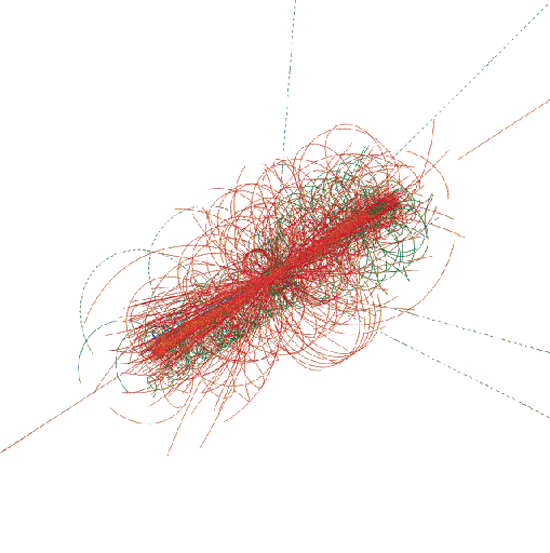
Astronomers are unable to observe the universe when it was very young, because truly far-away and long-ago events were engulfed in a sea of intense radiation. In the very early universe, no galaxies, stars, or planets had yet emerged. Only subatomic particles existed—not only the protons, neutrons and electrons we know today, but also, we think, various strange and exotic elementary particles predicted by current theory. Surprisingly, part of this melange of particles that characterized the early universe can now be studied here on Earth, in huge accelerators such as those of the Conseil Européen pour la Recherche Nucleaire (CERN) near Geneva, Switzerland. The odd image at left shows the violent collision of elementary particles, typical of events thought to have occurred about a trillionth of a second after the beginning of the universe. Two fast-moving protons (straight red lines) are shown colliding head on. Their encounter produces a multitude of charged particles, seen here curving in the magnetic field of the Large Hadron (proton) Collider at CERN. One rather massive particle thought to have played a unifying role in the early universe—a particle bizarrely named the Higgs boson—is depicted here amidst the debris, at the intersection of the straight green lines (which are yet other particles decaying in the aftermath of the violence). This image, however, is only a computer simulation; the Large Hadron Collider is still under construction, and the Higgs boson has not yet been seen by anyone. Whoever does eventually discover the Higgs (assuming it really exists) will doubtless win a free, all-expense-paid trip to Sweden—to pick up a Nobel Prize.
Studying this chapter will enable you to:
Describe the characteristics of the universe immediately after its birth.
Explain how matter emerged from the primeval fireball.
Enumerate the epochs in the evolutionary history of the universe and specify the major characteristics of each.
Explain how and when the simplest nuclei and atoms formed.
Summarize the horizon and flatness problems, and discuss the theory of cosmic inflation as a possible solution to these problems.
Explain the formation of large-scale structure in the cosmos, and discuss the observational evidence of our theories of structure formation.
What were the conditions during the first few seconds of the universe, and how did those conditions change to give rise to the universe we see today? In studying the earliest moments of our universe, we enter a truly alien domain. As we move backward in time toward the Big Bang, our customary landmarks slip away one by one. Atoms vanish, then nuclei, then even the elementary particles themselves. In the beginning the universe consisted of pure energy, at unimaginably high temperatures. As it expanded and cooled, the ancient energy gave rise to the particles that make up everything we see around us today. Modern physics has now arrived at the point where it can reach back almost to the instant of the Big Bang itself, allowing scientists to unravel some of the mysteries of our own beginning.